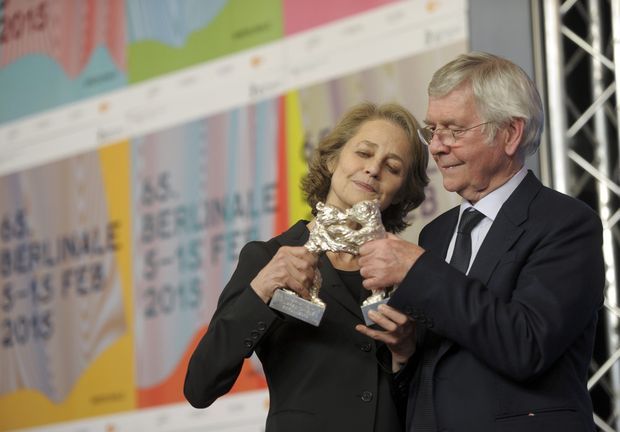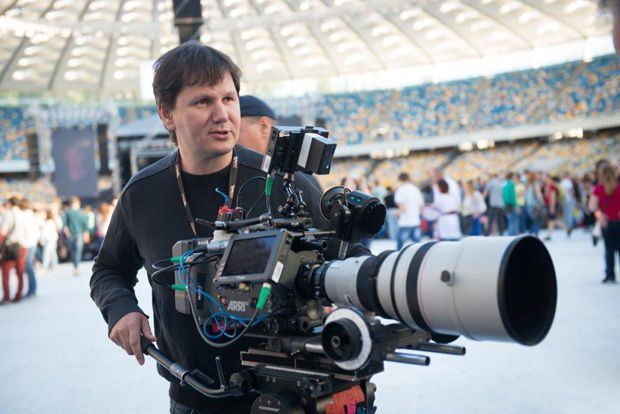Freely and beautifully
Art wins over politics at the Berlin Film Festival
Every time in a conversation about Berlinale I have to mention its important peculiarity: of all film forums of the A class it is the most politically biased. Founded in Western Berlin, a demonstrative feast of art behind the Wall, after the collapse of communism it transformed into a venue of meeting cultures, for a dialog about the world misfortunes. This has an influence on formation of the programs and allocating the prizes.
Therefore, for example, the main competition has certain quotas, according to which there is always a place for Asian, Latin American or East European cinema. Ukraine does not have any quotas, yet it has always been present there.
At the festival version of an authoritative international cinema publication, The Hollywood Reporter, an article was published “5 East European pics not to miss at EFM.” Myroslav Slaboshpytsky’s new project Luxemburg (which took part in the coproduction section) is listed the third. It is said that this is a “relationship drama about a troubled policeman will be shot entirely on the location within the still radioactive exclusion zone, which covers a territory the size of Luxembourg.”
On the same page Russian Aleksey German Jr. (Under Electric Clouds, Russia – Ukraine – Poland) answers the question whether current political tensions between Moscow and Kyiv stood in the way. The director denies any political pressure, although complains that there would be many people on both sides who are ready to accuse him of treachery.
However, the problem of Electric Clouds is neither about treachery, nor about the war. It is simply that from the first minutes you have a feeling that you are looking at some awkward parody of a production of Chekhov’s play. The only interesting component of the film is the visual environment in it, a cold picture with prevailing white, brown, and gray colors – a tone of crawling anti-utopia, where the characters live. This is the merit of the cameramen, Russian Evgeniy Privin and Ukrainian Serhii Mykhalchuk. The jury decided that they and Sturla Brandth Grovlen (criminal thriller Victoria, Germany) deserved a Silver Bear for the outstanding artistic contribution.
Serhii Mykhalchuk, 42, is probably the most renowned Ukrainian cameraman these days. Having started with music videos and commercials, he moved to television, documentary, and live action films. This year’s Bear is the first award of such a level won by Ukrainian cinematography over the period of Ukraine’s independence; it is left to hope that this award is not the last one.
As for the winner of the Golden Bear for the best film, Jafar Panahi, an Iranian director did not represent his native country, the Islamic Republic, because he had been accused of antigovernment activity in his homeland and had been banned from shooting films, communicating with the press, and going abroad for 20 years. However, Taxi is the third feature film director has shot after the verdict was announced.
Panahi was facing a complicated task: he had to shoot a film without shooting it. What did he do? He went to work as a taxi driver. This is a simple trick used many times: different stories unfold in a cab of a taxi driver. In Panahi’s movies it becomes incredibly fresh, because not only is he a wonderful director, but also a very good actor who works on the verge of everyday routine, cinema, documentary, and live action cinema, at the same time creating stories and thinking aloud about the meaning of his profession. The everyday reality and cinema fiction are combined with escheated reality of ideology – and Panahi copes with all three realities in a virtuoso manner, constantly making them clash, and at every collision getting the energy of real art. In such a way an act of deceiving censure becomes a film of tracery beauty – at the same time it is a comedy, a high drama, and a protest manifesto.
The second general favorite, Ixcanul Volcano, was a double debut: first, Guatemala had never taken part in Berlinale before; second, this is the first feature film by 38-year-old Jayro Bustamante.
The heroes of the film are peasants, Maya Indians. They are earning their living by gathering coffee beans on a plantation; this is hard work. An active volcano is located nearby. It must be coaxed with prayers and sacrifices. The poverty is outrageous. The only way to get a better life is to go illegally to the US or marry daughter Maria to the owner of the plantation. The film, actually, starts with a scene when at an engagement dinner everyone is discussing the heroine as an article of trade.
Bustamante was not carried away by temptation to create an attraction of folklore or scenery exotics. The most important thing for him is to tell a story. All the actors are seamless and comprehensive; the beautiful nature and city interiors are appropriate as the environment the heroes live in; they in different ways underline their lawlessness and their will to life. Bustamante escaped another risk: of making up a fairytale about a Cinderella or a dark film about a dishonored commoner. Ixcanul is not a poetic cinema toy, but an honest and consistent in shape social drama. Bustamante gave voice to his community. He made a poetic movie which is not based on some shaman rituals or funny indigenes, but on ordinary heroism of these people; the discovery of new ways in art earned him the Alfred Bauer Prize.

THE JURY AWARDED THE SILVER BEAR TO UKRAINIAN SERHII MYKHALCHUK, CINEMATOGRAPHER OF THE PICTURE UNDER ELECTRIC CLOUDS, BUT HE COULD NOT ATTEND THE BERLIN AWARD CEREMONY BECAUSE HE STARTED SHOOTING A NEW FILM ABOUT THE BOLSHOI THEATER FOR DIRECTOR VALERY TODOROVSKY ON THAT VERY DAY
The plot of Body by Pole Malgorzata Szumowska also deals with a conflict of generations, in this case this is a conflict between a daughter and a father. They both are obsessed with human body, but in different ways. The father is a detective who is able to absolutely indifferently examine and protocol the places of the most terrible crimes. And the daughter is afraid to put on weight, which is why she is torturing herself: she eats nonstop and nonstop vomits everything she ate, which makes her almost faint. Besides, she hates her father, and there is only one thing that unites them – the death of her mother. They are trying to find reconciliation with the help of an eccentric psychotherapist, who considers herself a medium able to contact the dead.
Szumowska adds to the potentially hopeless situation a well-measured bit of irony, not forgetting about the convincing share of drama and gets in the end a touching, but not sentimental story with a sunny and not banal final reconciliation.
However, the jury decided to share the Bear between Body and Romanian Aferim! (Radu Jude) – a black-and-white costume drama refers to 1835 and shows a macho constable and his asthenical son chasing a Roma slave who escaped from his landowner. The problem with this movie is common for all historical pictures – heroes serve as an attachment to the entourage. But it seems that namely the restrained colors and barbaric final solved the matter and the unending “Romanian wave” got another festival encouragement.
The American solitary director Terrence Malick, an idol of cinema aesthetes (especially after the Golden Palm in Cannes for his Tree of Life in 2011) was left without any award, like the living legend of the filmmaking postmodernism, British Peter Greenaway.
In Knight of Cups Malick decided not only to work on the topic about the earthly living as a dream, but also to combat a linear plot. Christian Bale plays an oversaturated Hollywood screenwriter who is looking for the meaning of life; however, this search limits itself to seducing another beauty or going to another party – all this is accompanied by heartfelt monologs off scene. The cityscapes and landscapes that satisfy the eye, the luxurious panoramas, and the camera that is zooming in and flying, – all of this is apparently supposed to create a needed degree of visionary, but the result is only a mixture of Discovery channel and a contest of fashionable wet suits.
Greenaway finally stopped to turn his films into catalogs and quotation collections, but shot a traditional biographic drama Eisenstein in Guanajuato. According to Greenaway, Eisenstein is an eccentric man of genius, a rebel who does not know a minute of rest; he is all the time talking, shouting, eating, drinking, stealing forks, making love, dancing in a Mexican town painted in nostalgic colors of classical Technicolor. The story can be told in one phrase: Eisenstein falls in love with a handsome guide who has a wife and two children, but the parting is inevitable. According to director, this is “Ten days that shocked Eisenstein,” but in fact this is 105 minutes that partially renewed interest to Greenaway. However, this interest is not enough to bring him back into the focus of the mass attention of cinema lovers.
The Pearl Button by patriarch of Chilean non-action filmmaking, 74-year-old Patricio Guzman, seems to be a visual rhyme to Malick’s picture. This is a documentary epos about water and death. The picture is as well full of beautiful scenes shot in the manner of educational TV channels and the monolog beyond the scenes sticks the range of videos together, delivering a lecture about physics, metaphysics, and metaphoric nature of water, the coast of Patagonia (thousands of fjords and islands, wonderful shooting from the air); about Indians who are able to swim on a canoe for thousands of kilometers across a stormy ocean; about almost total destruction of this unique people by white settlers with the help of the government; about the dictatorship of Pinochet. The story closes in the same places, and the most impressive plot connection is established between two pearl buttons – at first an Indian was bought for a handful of such buttons in the 19th century. The purchaser was going to make a “gentleman” of him, but instead damaged him mentally and morally; those buttons are as like as two peas with the button from a shirt of Pinochet’s victim found on the sea bottom; and in the space there is a watery nebula, which is 120 billion times larger than the world ocean, and maybe there is room for all homeless Indian souls whose owners believed that they would turn into stars after death.
On the whole, 20 participants competed for the awards; the films mentioned above are the most interesting. They seem to be pretty enough to spur two conclusions: aesthetic things prevailed over politics at the 65th Berlinale – within reasonable limits, and the leadership was taken by the countries which had previously belonged to developing or post-Communist states.
In other words, the Third World, freedom, and art won the day. And this is good.






